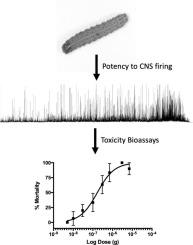Pesticide Biochemistry and Physiology ( IF 4.2 ) Pub Date : 2021-09-20 , DOI: 10.1016/j.pestbp.2021.104965 Sarah E McComic 1 , Leslie C Rault 2 , Troy D Anderson 2 , Daniel R Swale 1

|
The fall armyworm (FAW), Spodoptera frugiperda, is a global pest of multiple economically important row crops and the development of resistance to commercially available insecticidal classes has inhibited FAW control. Thus, there is a need to identify chemical scaffolds that can provide inspiration for the development of novel insecticides for FAW management. This study aimed to assess the sensitivity of central neurons and susceptibility of FAW to chloride channel modulators to establish a platform for repurposing existing insecticides or designing new chemicals capable of controlling FAW. Potency of select chloride channel modulators were initially studied against FAW central neuron firing rate and rank order of potency was determined to be fipronil > lindane > Z-stilbene > DIDS > GABA > E-stilbene. Toxicity bioassays identified fipronil and lindane as the two most toxic modulators studied with topical LD50's of 41 and 75 ng/mg of caterpillar, respectively. Interestingly, Z-stilbene was toxic at 300 ng/mg of caterpillar, but no toxicity was observed with DIDS or E-stilbene. The significant shift in potency between stilbene isomers indicates structure-activity relationships between stilbene chemistry and the binding site in FAW may exist. The data presented in this study defines the potency of select chloride channel modulators to FAW neural activity and survivorship to establish a platform for development of novel chemical agents to control FAW populations. Although stilbenes may hold promise for insecticide development, the low toxicity of the scaffolds tested in this study dampen enthusiasm for their development into FAW specific insecticides.
中文翻译:

芪对秋粘虫Spodoptera frugiperda的毒理学分析
秋粘虫 (FAW)草地夜蛾是多种具有重要经济意义的中耕作物的全球害虫,对市售杀虫剂类别的抗性发展抑制了秋粘虫的控制。因此,需要确定可以为开发用于秋粘虫管理的新型杀虫剂的化学支架。本研究旨在评估中枢神经元的敏感性和秋粘虫对氯通道调节剂的敏感性,以建立一个平台来重新利用现有杀虫剂或设计能够控制秋粘虫的新化学品。最初针对 FAW 中枢神经元放电率研究了选择的氯通道调节剂的效力,效力的等级顺序确定为氟虫腈 > 林丹 > Z-二苯乙烯> DIDS > GABA > E -二苯乙烯。毒性生物测定将氟虫腈和林丹鉴定为两种毒性最强的调节剂,分别用 41 和 75 ng/mg 的毛虫局部 LD 50进行研究。有趣的是,Z-二苯乙烯在 300 ng/mg 毛虫时是有毒的,但在 DIDS 或E 中没有观察到毒性-二苯乙烯。二苯乙烯异构体之间效力的显着变化表明二苯乙烯化学与FAW中的结合位点之间可能存在构效关系。本研究中提供的数据定义了选择氯通道调节剂对秋粘虫神经活动和存活率的效力,以建立一个开发新型化学制剂以控制秋粘虫种群的平台。尽管芪可能有望用于杀虫剂的开发,但本研究中测试的支架的低毒性抑制了将其开发为一汽特定杀虫剂的热情。











































 京公网安备 11010802027423号
京公网安备 11010802027423号